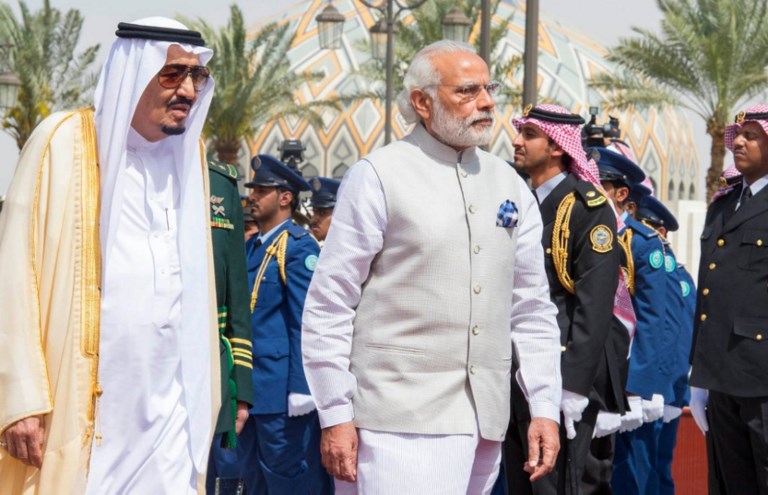Since the accession of Saudi King Salman in 2015 and the rise to power of his son, Crown Prince Mohammed bin Salman, Saudi Arabia and the UAE have formed a formidable bloc. Determined to transform the region, they have confronted Iran, the Houthis in Yemen, Qatar and transnational Islamist groups including the Muslim Brotherhood. In a region that represents a primary source of energy, overseas employment and financial remittances for India, how likely is India to find common cause with the resurgent Saudi-Emirati bloc?
Because of India’s diverse interests in the region, it is unlikely to openly cheerlead recent Saudi-Emirati efforts, some of which have been described in sections of the Indian press as “reckless.” But New Delhi is likely to welcome the Saudi and Emirati campaign against transnational Islamist groups, even if it looks more skeptically at their growing confrontation with Iran and boycott of Qatar. India has long opposed transnational Islamist groups that it considers a dangerous radicalising force, especially in the Indian state of Jammu and Kashmir. As a result, Saudi Arabia’s support for the Afghan jihad against the Soviets during the 1980s was a major irritant in Indo-Saudi relations. Indian authorities blamed Afghan arms and fighters for fuelling the insurgency in Kashmir once the Soviet invasion was over. The Indian government has also been critical of Saudi patronage for local Deobandi and Salafist Muslim institutions in India, many of which the Indian government claims are extremist incubators.
So when Saudi Crown Prince Mohammed promised to “crush” extremists and reinstate a more tolerant version of Islam, the Indian government probably applauded in joy. Over the past three years, Saudi Arabia and the UAE have put Prince Mohammed’s pledge into effect, waging an unprecedented campaign against transnational Islamist groups, including the Muslim Brotherhood, across the region. In 2014, Saudi Arabia and the UAE officially designated the Muslim Brotherhood a terrorist organization. Since then, they have taken their fight against the group to Egypt, where they have backed President Abdel Fattah El-Sisi’s security crackdown, to Libya, where they have provided air cover for the forces of General Khalifa Haftar against Islamist factions in Tripoli, and to Qatar, which they have boycotted partly over its ties to the Muslim Brotherhood. In Yemen, Saudi Arabia and the UAE apparently have temporarily joined forces with Al-Islah party to take on the Houthis; the former is the local Muslim Brotherhood affiliate.
Beyond eradicating the region’s transnational Islamist groups, the Saudi-Emirati bloc has stepped up efforts to reverse Iran’s growing influence in the region. To that end, it has waged war in Yemen against the Houthis (whom the Saudis and Emiratis view as Iranian proxies), encouraged US President Trump to revise the nuclear deal with Iran, and lent support to nationalist leaders in Iraq such as Shia cleric Muqtada Al-Sadr to roll back Iranian influence. More recently, Prince Mohammed pledged on American TV to match Iran’s nuclear capabilities should it ever acquire a nuclear weapon, making clear his commitment to maintaining strategic parity with Iran.
Despite the new direction that Saudi-Emirati foreign policy has taken, many in Delhi believe that because of its shared interests with Iran, India should refrain from taking sides in regional conflict. Nevertheless, this traditional image of a strategic Indian convergence with Iran seems set to change. Iran has increasingly backed the Taliban’s efforts to recapture territory in Afghanistan, which it hopes will haemorrhage Nato forces and weaken Afghanistan’s US-supported government. India, meanwhile, has moved toward closer alignment with the US in Afghanistan, approving transfers of military helicopters and arms to the Afghan government. India’s energy trade with Iran has also failed to pick up completely following the Iran nuclear deal in 2015, partly because the threat of US sanctions under Trump continues to loom over Iran’s energy sector. India’s relations with Iran, as Delhi may soon realize, may no longer be enough to constrain its ability to form tighter bonds with Saudi Arabia and the UAE.
Apart from Iran, an often-overlooked sticking point in the prospect of India finding common cause with a resurgent Saudi-Emirati bloc, may be Qatar. The Saudis and Emiratis have led a nine-month long boycott of Qatar over accusations that Doha has continued to harbour the Muslim Brotherhood and sow popular discontent through the Al Jazeera TV network, despite a 2014 agreement to the contrary. Because of its stakes in Qatar’s stability, India has refrained from taking sides. Amid initial rumours of a shortfall in food and water supplies in Doha, the Indian government’s initial response was to seek assurances from these governments for the safety and well-being of its citizens. Because Qatar is an important source of LNG, India was concerned the boycott would lead to an interruption of supply, an outcome that has so far not materialized. To preserve the appearance of neutrality, India is unlikely to veer too closely yet in favour of the Saudi-Emirati policy in the region.
Ultimately, India seems keen to avoid a zero-sum alignment in the region where a close association with the Saudi-Emirati bloc might entail a retreat in relations with Iran or Qatar. Whether and how quickly India’s mindset on Iran changes and the dispute with Qatar ends remains an open question, but because of their animosity toward transnational Islamist groups, New Delhi should find ample room to work with the Saudis and Emiratis on a common agenda in the region.
Hasan Alhasan is a PhD researcher at King’s College London and the National University of Singapore, where his work focuses on Indian foreign policy in the Middle East. Previously, he served as a senior analyst at the office of the first deputy prime minister of Bahrain.
AFP PHOTO/HO/SPA

